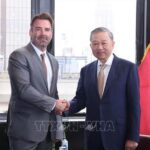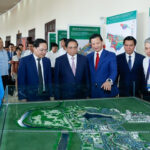
Deputy Prime Minister Tran Hong Ha: Developing high-speed railways, urban railways, and Vietnamese railways in general will boost the mechanical, manufacturing, and automation industries. – Photo: VGP/Minh Khoi
|
At the 10th Conference of the 13th Party Central Committee (September 2024), the Party Central Committee and the Politburo agreed on the policy to invest in the North-South high-speed rail project, considering it a political task and prioritizing resources for early implementation.
Focusing investment for development leverage
Currently, the Ministry of Transport and related units are urgently completing the pre-feasibility study report for the investment project of the North-South high-speed railway, preparing procedures to submit to the National Assembly for consideration and opinion at the October 2024 session.
According to the report by Deputy Minister of Transport Nguyen Danh Huy, the investment objective is to build a high-speed railway to meet transport needs, contribute to restructuring the transport market share on the North-South corridor in an optimal and sustainable way, create a premise and driving force for socio-economic development, and ensure national defense and security.
Specifically, the project aims to approve the investment policy before 2025, complete site clearance and start construction before 2030, and complete the entire route before 2045.
The project’s investment scope has its starting point in Hanoi: The Ngoc Hoi Station Complex (the southern transport hub for passengers and cargo of the Hanoi railway hub). The endpoint is in Ho Chi Minh City: Thu Thiem Station (the eastern transport hub for passengers of the Ho Chi Minh City railway hub).
The project will pass through 20 provinces and cities, including Hanoi, Ha Nam, Nam Dinh, Ninh Binh, Thanh Hoa, Nghe An, Ha Tinh, Quang Binh, Quang Tri, Thua Thien-Hue, Da Nang, Quang Nam, Quang Ngai, Binh Dinh, Phu Yen, Khanh Hoa, Ninh Thuan, Binh Thuan, Dong Nai, and Ho Chi Minh City.
To optimize transport costs, take advantage of each mode’s strengths, international experience, the current infrastructure system capacity, transport demand forecasts, and the function of the North-South railway line, the pre-feasibility study report proposes: Building a new double-track railway with a standard gauge of 1,435 mm, electrification, a design speed of 350 km/h, and an axle load of 22.5 tons; the length is about 1,541 km with 23 passenger stations and 5 cargo stations; the North-South high-speed railway will transport passengers, meet the requirements of dual-use for national defense and security, and can transport cargo if necessary; the existing North-South railway will transport cargo and short-haul tourists.
At the meeting, delegates said that investing in a large project like the North-South high-speed railway needs to “tighten our belts” to focus investment and create leverage for development.
Leaders of the Ministry of Planning and Investment, the Ministry of Finance, the Ministry of Science and Technology, and the Ministry of Information and Communications discussed and clarified some groups of special mechanisms and policies in the pre-feasibility study report to be submitted to the National Assembly at the upcoming session, such as the project’s investment scope, investment efficiency for the railway sector and the economy, investment forms, capital mobilization solutions, implementation plans to connect with other transport modes, directions for developing railway industry and services, efficient exploitation of land funds along the route, decentralization and delegation to ministries, sectors, and localities…
 Delegates said that investing in a large project like the North-South high-speed railway needs to “tighten our belts” to focus investment and create leverage for development – Photo: VGP/Minh Khoi
|
There must be a mechanism for localities and businesses
Concluding the working session, Deputy Prime Minister Tran Hong Ha requested the Ministry of Transport to receive and thoroughly grasp the directions of the Party Central Committee and the Politburo, as well as the enthusiastic contributions of ministries, sectors, experts, and people; continue to update and complete the pre-feasibility study report to submit to the National Assembly, focusing on issues with scientific and practical bases.
Specifically, in addition to the investment scope from the starting point of the project in Hanoi to the endpoint in Ho Chi Minh City, it is also necessary to consider and study the option of extending the high-speed railway from Mong Cai to Ca Mau.
“The Ministry of Transport must analyze the advantages and benefits of investing in the entire route, which will connect synchronously with other transport modes, compared to investing in some sections first. Evaluate the efficiency of the high-speed railway specialized in passenger transport (or combined with cargo transport if necessary) for the whole economy, not just the railway industry,” said the Deputy Prime Minister.
In addition, the pre-feasibility report should reflect the view of investing in a railway with a design speed of 350 km/h, which is “as straight as possible,” “going through mountains and building bridges over rivers.”
Regarding the investment implementation form, the Deputy Prime Minister requested the Ministry of Transport to clearly point out the advantages and disadvantages of considering the entire route as one project or having multiple sub-projects; propose specific mechanisms and policies on investment division, capital allocation from the central budget, localities once or every five years, the use of bonds, ODA, and other legal sources, taking advantage of the remaining space of the public debt ceiling.
In addition, the Ministry of Transport needs to propose solutions to enhance decentralization and delegation, assigning responsibilities to localities for site clearance preparation, construction of technical infrastructure works, stations…, while the central level uniformly manages standards and norms from design, infrastructure, means of transport, information systems, management…; at the same time, “assign tasks” to private enterprises to mobilize external resources, from the land fund on both sides of the railway route, to reduce the costs and resources of the State.
“The specific mechanisms and policies that have been applied to urban railways in Hanoi and Ho Chi Minh City need to be considered for application in localities where the railway route passes through,” the Deputy Prime Minister said, reiterating that “the project must have a mechanism for localities and private enterprises.”
The Deputy Prime Minister assigned the Ministry of Industry and Trade to take the prime responsibility and coordinate with the Ministry of Transport, the Vietnam Railway Authority, the Vietnam Railway Corporation, and some large enterprises to build and implement a roadmap to receive, transfer, and master railway technology and develop the railway industry, from manufacturing equipment to operation and management; ensure uniformity and consistency in technology, standards, and norms.
“Developing high-speed railways, urban railways, and Vietnamese railways, in general, will boost the mechanical, manufacturing, and automation industries and other industries serving the country’s economy and people’s lives,” emphasized the Deputy Prime Minister.
The Ministry of Education and Training was assigned to take the prime responsibility and coordinate with the Ministry of Transport to build and implement human resource training in advance, ready to receive, master, and autonomously apply technology, technical design, equipment manufacturing, operation, and management in the railway sector.
The Tech Giants and American Investment Funds: Expanding Horizons in Vietnam
On the sidelines of the 79th Session of the UN General Assembly in New York, General Secretary and President To Lam held a meeting with former Google CEO Eric Schmidt, along with leading technology companies and investment funds from the US and beyond. The gathering included representatives from Apple, Meta, Super Micro, and investment giants Blackstone and Warbug Pincus.


















